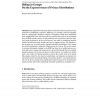Free Online Productivity Tools
i2Speak
i2Symbol
i2OCR
iTex2Img
iWeb2Print
iWeb2Shot
i2Type
iPdf2Split
iPdf2Merge
i2Bopomofo
i2Arabic
i2Style
i2Image
i2PDF
iLatex2Rtf
Sci2ools
SEC
2008
2008
Hiding in Groups: On the Expressiveness of Privacy Distributions
Many applications inherently disclose information because perfect privacy protection is prohibitively expensive. RFID tags, for example, cannot be equipped with the cryptographic primitives needed to completely shield their information from unauthorized reads. All known privacy protocols that scale to the anticipated sizes of RFID systems achieve at most modest levels of protection. Previous analyses found the protocols to have weak privacy, but relied on simplifying attacker models and did not provide insights into how to improve privacy. We introduce a new general way to model privacy through probability distributions, that capture how much information is leaked by different users of a system. We use this metric to examine information leakage for an RFID tag from the a scalable privacy protocol and from a timing side channel that is observable through the tag's random number generator. To increase the privacy of the protocol, we combine our results with a new model for rational ...
| Added | 30 Oct 2010 |
| Updated | 30 Oct 2010 |
| Type | Conference |
| Year | 2008 |
| Where | SEC |
| Authors | Karsten Nohl, David Evans |
Comments (0)

